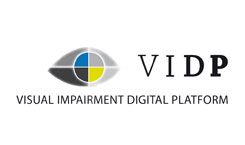
Visual Impairment Digital Platform
At present, the existing viewing aids and accessibility tools are rarely mobile and are usually heavy and expensive. They consist of electronics, mechanics, optics and a minimum of software. Their images cannot be adjusted according to individual eye diseases or individual patient parameters.
Digital devices with micro displays, micro cameras and software (to manipulate the image in real time) are not existing. Combining off-the-shelf components such as micro displays and micro cameras with embedded electronics and the latest processor techniques will create an universal, flexible digital viewing aid similar to goggles or HMD. Together with eye tracking, the user can control all functions of his device, and the image enhancements can be presented individually into the correct viewing position.
The planned digital platform will be mobile, small and easily programmable to accommodate the patient’s particular degree of disablement. It will be flexible for later adaptation, in the case of changed patient’s parameters. The platform can be upgraded by additional features such as with plug-in modules.
The result is one device for (at least) these following diseases: Macular Degeneration – Morbus Stargardt – Morbus Best – Retinitus Pigmentosa – Diabetic Retinopatie – Usher Syndrome – Diabetes – Cataract – Glaucoma – N. Optic neuropathy – Retinal Vascular accident – Albinism – Cornea Dystrophy – Hemianopia.
The same device can also be used for therapies and rehabilitation of Cortical Blindness patients as well as help in certain cases of Parkinson’s disease. Several additional features are possible. For example, the device can be used as a reading magnifier for aging people either stationary or mobile. Combined with OCR techniques and simple audio output, the device could read short texts, even when travelling or in poor light conditions. The integration of navigation techniques (GPS, maps) is very useful and gives additional benefit to the device since this information can be presented according to individual needs – what is impossible for current market products.
The combination of the NTE (near the eye) see-through optic, highly integrated electronics and the flexibility of software will reduce volume and price. The same device will be able to project text or images (i. e. maps) magnified on walls or on flat surfaces. Distance sensors can alert the person whose head is approaching an object. The integrated audio can update various and multiple situations or the features’ status. For aging people, it will enable them to keep their independency and mobility.
The device can be used hands free as HMD, as goggles or as handheld binoculars, hanging around the neck if not used. The NTE optics offers the advantage to display good image quality even in bright ambient light conditions, compared to direct view LCD screens. One of the key elements of the digital viewing aid is a transparent Head-Mounted-Display which does not block the user’s sight. This is combined with video-see-through and the ability to enhance images compensating for the patient’s viewing disabilities by using a camera.
For example, such a camera can aid one to see better at night, auto focus for sharper images, give brilliant colours and, most importantly, magnify the scene by optical/digital zoom. The algorithms can adjust and enhance the image, depending on the individual user’s needs. Diopter adjustments and parallax corrections are implemented into the near-the-eye (NTE) optics. Additionally, an optician can add correction lenses and adapt the parameters of the software algorithm with any computer.
Partners
Funding by: BMBF
